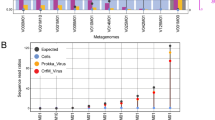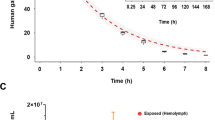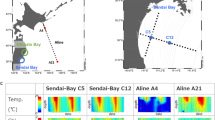Abstract
Diverse microbes release membrane-bound extracellular vesicles from their outer surfaces into the surrounding environment. Vesicles are found in numerous habitats including the oceans, where they likely have a variety of functional roles in microbial ecosystems. Extracellular vesicles are known to contain a range of biomolecules including DNA, but the frequency with which DNA is packaged in vesicles is unknown. Here, we examine the quantity and distribution of DNA associated with vesicles released from five different bacteria. The average quantity of double-stranded DNA and size distribution of DNA fragments released within vesicles varies among different taxa. Although some vesicles contain sufficient DNA to be visible following staining with the SYBR fluorescent DNA dyes typically used to enumerate viruses, this represents only a small proportion (<0.01–1%) of vesicles. Thus DNA is packaged heterogeneously within vesicle populations, and it appears that vesicles are likely to be a minor component of SYBR-visible particles in natural sea water compared with viruses. Consistent with this hypothesis, chloroform treatment of coastal and offshore seawater samples reveals that vesicles increase epifluorescence-based particle (viral) counts by less than an order of magnitude and their impact is variable in space and time.
Similar content being viewed by others
Log in or create a free account to read this content
Gain free access to this article, as well as selected content from this journal and more on nature.com
or
References
Ackermann H-W, DuBow MS . (1987) Viruses of Prokaryotes. CRC Press: Boca Raton, FL, USA.
Bankevich A, Nurk S, Antipov D, Gurevich AA, Dvorkin M, Kulikov AS et al. (2012). SPAdes: a new genome assembly algorithm and its applications to single-cell sequencing. J Comput Biol 19: 1–23.
Berube PM, Biller SJ, Kent AG, Berta-Thompson JW, Roggensack SE, Roache-Johnson KH et al. (2015). Physiology and evolution of nitrate acquisition in Prochlorococcus. ISME J 9: 1195–1207.
Biers EJ, Wang K, Pennington C, Belas R, Chen F, Moran MA . (2008). Occurrence and expression of gene transfer agent genes in marine bacterioplankton. Appl Environ Microbiol 74: 2933–2939.
Biller SJ, Coe A, Martin-Cuadrado A-B, Chisholm SW . (2015). Draft genome sequence of Alteromonas macleodii strain MIT1002, isolated from an enrichment culture of the marine cyanobacterium Prochlorococcus. Genome Announc 3: e00967–15.
Biller SJ, Schubotz F, Roggensack SE, Thompson AW, Summons RE, Chisholm SW . (2014). Bacterial vesicles in marine ecosystems. Science 343: 183–186.
Bonnington KE, Kuehn MJ . (2014). Protein selection and export via outer membrane vesicles. Biochim Biophys Acta 1843: 1612–1619.
Brown L, Wolf JM, Prados-Rosales R, Casadevall A . (2015). Through the wall: extracellular vesicles in Gram-positive bacteria, mycobacteria and fungi. Nat Rev Microbiol 13: 620–630.
Brum JR, Schenck RO, Sullivan MB . (2013). Global morphological analysis of marine viruses shows minimal regional variation and dominance of non-tailed viruses. ISME J 7: 1738–1751.
Brum JR, Sullivan MB . (2015). Rising to the challenge: accelerated pace of discovery transforms marine virology. Nat Rev Microbiol 13: 147–159.
Brussaard CP, Marie D, Bratbak G . (2000). Flow cytometric detection of viruses. J Virol Methods 85: 175–182.
Brussaard CPD . (2009). Enumeration of bacteriophages using flow cytometry. Methods Mol Biol 501: 97–111.
Brussaard CPD . (2004). Optimization of procedures for counting viruses by flow cytometry. Appl Environ Microbiol 70: 1506–1513.
Camacho C, Coulouris G, Avagyan V, Ma N, Papadopoulos J, Bealer K et al. (2009). BLAST+: architecture and applications. BMC Bioinformatics 10: 421.
Chen F, Lu J-R, Binder BJ, Liu Y-C, Hodson RE . (2001). Application of digital image analysis and flow cytometry to enumerate marine viruses stained with SYBR Gold. Appl Environ Microbiol 67: 539–545.
Culley AI, Lang AS, Suttle CA . (2006). Metagenomic analysis of coastal RNA virus communities. Science 312: 1795–1798.
Deatherage BL, Cookson BT . (2012). Membrane vesicle release in bacteria, eukaryotes, and archaea: a conserved yet underappreciated aspect of microbial life. Infect Immun 80: 1948–1957.
Dorward DW, Garon CF . (1990). DNA is packaged within membrane-derived vesicles of Gram-negative but not Gram-positive bacteria. Appl Environ Microbiol 56: 1960–1962.
Dorward DW, Garon CF, Judd RC . (1989). Export and intercellular transfer of DNA via membrane blebs of Neisseria gonorrhoeae. J Bacteriol 171: 2499–2505.
Ellis TN, Kuehn MJ . (2010). Virulence and immunomodulatory roles of bacterial outer membrane vesicles. Microbiol Mol Biol Rev 74: 81–94.
Espejo RT, Canelo ES . (1968). Properties and characterization of the host bacterium of bacteriophage PM2. J Bacteriol 95: 1887–1891.
Fischer MG, Allen MJ, Wilson WH, Suttle CA . (2010). Giant virus with a remarkable complement of genes infects marine zooplankton. Proc Natl Acad Sci USA 107: 19508–19513.
Forterre P, Soler N, Krupovic M, Marguet E, Ackermann H-W . (2013). Fake virus particles generated by fluorescence microscopy. Trends Microbiol 21: 1–5.
Frias A, Manresa A, de Oliveira E, López-Iglesias C, Mercade E . (2010). Membrane vesicles: a common feature in the extracellular matter of cold-adapted antarctic bacteria. Microbial Ecol 59: 476–486.
Gaudin M, Krupovic M, Marguet E, Gauliard E, Cvirkaite-Krupovic V, Le Cam E et al. (2014). Extracellular membrane vesicles harbouring viral genomes. Environ Microbiol 16: 1167–1175.
Grande R, Di Marcantonio MC, Robuffo I, Pompilio A, Celia C, Di Marzio L et al. (2015). Helicobacter pylori ATCC 43629/NCTC 11639 outer membrane vesicles (OMVs) from biofilm and planktonic phase associated with extracellular DNA (eDNA). Front Microbiol 6: 1114–11.
Hara S, Terauchi K, Koike I . (1991). Abundance of viruses in marine waters: assessment by epifluorescence and transmission electron microscopy. Appl Environ Microbiol 57: 2731–2734.
Hennes KP, Suttle CA . (1995). Direct counts of viruses in natural waters and laboratory cultures by epifluorescence microscopy. Limnol Oceanogr 40: 1050–1055.
Holmfeldt K, Odić D, Sullivan MB, Middelboe M, Riemann L . (2012). Cultivated single-stranded DNA phages that infect marine Bacteroidetes prove difficult to detect with DNA-binding stains. Appl Environ Microbiol 78: 892–894.
Hopkins M, Kailasan S, Cohen A, Roux S, Tucker KP, Shevenell A et al. (2014). Diversity of environmental single-stranded DNA phages revealed by PCR amplification of the partial major capsid protein. ISME J 8: 2093–2103.
Höög JL, Lötvall J . (2015). Diversity of extracellular vesicles in human ejaculates revealed by cryo-electron microscopy. J Extracell Vesicles 4: 28680.
Hurwitz BL, U’Ren JM . (2016). Viral metabolic reprogramming in marine ecosystems. Curr Opin Microbiol 31: 161–168.
Jiang Y, Kong Q, Roland KL, Curtiss R III . (2014). Membrane vesicles of Clostridium perfringens type A strains induce innate and adaptive immunity. Int J Med Microbiol 304: 431–443.
Jover LF, Effler TC, Buchan A, Wilhelm SW, Weitz JS . (2014). The elemental composition of virus particles: implications for marine biogeochemical cycles. Nat Rev Microbiol 12: 519–528.
Kadurugamuwa JL, Beveridge TJ . (1995). Virulence factors are released from Pseudomonas aeruginosa in association with membrane vesicles during normal growth and exposure to gentamicin: a novel mechanism of enzyme secretion. J Bacteriol 177: 3998–4008.
Kesty NC, Kuehn MJ . (2004). Incorporation of heterologous outer membrane and periplasmic proteins into Escherichia coli outer membrane vesicles. J Biol Chem 279: 2069–2076.
Kim K-H, Bae J-W . (2011). Amplification methods bias metagenomic libraries of uncultured single-stranded and double-stranded DNA viruses. Appl Environ Microbiol 77: 7663–7668.
Klieve AV, Yokoyama MT, Forster RJ, Ouwerkerk D, Bain PA, Mawhinney EL . (2005). Naturally occurring DNA transfer system associated with membrane vesicles in cellulolytic Ruminococcus spp. of ruminal origin. Appl Environ Microbiol 71: 4248–4253.
Koliha N, Wiencek Y, Heider U, Jüngst C, Kladt N, Krauthäuser S et al. (2016). A novel multiplex bead-based platform highlights the diversity of extracellular vesicles. J Extracell Vesicles 5: 29975.
Kowal J, Arras G, Colombo M, Jouve M, Morath JP, Primdal-Bengtson B et al. (2016). Proteomic comparison defines novel markers to characterize heterogeneous populations of extracellular vesicle subtypes. Proc Natl Acad Sci USA 113: E968–E977.
Krupovic M, Bamford DH . (2007). Putative prophages related to lytic tailless marine dsDNA phage PM2 are widespread in the genomes of aquatic bacteria. BMC Genomics 8: 236–239.
Labonté JM, Suttle CA . (2013). Previously unknown and highly divergent ssDNA viruses populate the oceans. ISME J 7: 2169–2177.
Lang AS, Beatty JT . (2010). Gene transfer agents and defective bacteriophages as sources of extracellular prokaryotic DNA. In: Extracellular Nucleic Acids, Vol. 25, Springer Berlin Heidelberg: Berlin, Germany, pp 15–24..
Lang AS, Zhaxybayeva O, Beatty JT . (2012). Gene transfer agents: phage-like elements of genetic exchange. Nat Rev Microbiol 10: 472–482.
MacDonald IA, Kuehn MJ . (2012). Offense and defense: microbial membrane vesicles play both ways. Res Microbiol 163: 607–618.
MacDonald IA, Kuehn MJ . (2013). Stress-induced outer membrane vesicle production by Pseudomonas aeruginosa. J Bacteriol 195: 2971–2981.
Manning AJ, Kuehn MJ . (2011). Contribution of bacterial outer membrane vesicles to innate bacterial defense. BMC Microbiol 11: 258.
Marie D, Brussaard CPD, Thyrhaug R, Bratbak G, Vaulot D . (1999). Enumeration of marine viruses in culture and natural samples by flow cytometry. Appl Environ Microbiol 65: 45–52.
Martínez Martínez J, Boere A, Gilg I, van Lent J, Witte HJ, van Bleijswijk J et al. (2015). New lipid envelope-containing dsDNA virus isolates infecting Micromonas pusilla reveal a separate phylogenetic group. Aquat Microb Ecol 74: 17–28.
McBroom AJ, Johnson AP, Vemulapalli S, Kuehn MJ . (2006). Outer membrane vesicle production by Escherichia coli is independent of membrane instability. J Bacteriol 188: 5385–5392.
McDaniel LD, Young E, Delaney J, Ruhnau F, Ritchie KB, Paul JH . (2010). High frequency of horizontal gene transfer in the oceans. Science 330: 50.
Moore L, Coe A, Zinser ER, Saito M, Sullivan M, Lindell D et al. (2007). Culturing the marine cyanobacterium Prochlorococcus. Limnol Oceanogr Methods 5: 353–362.
Noble RT, Fuhrman JA . (1998). Use of SYBR Green I for rapid epifluorescence counts of marine viruses and bacteria. Aquat Microb Ecol 14: 113–118.
Overballe-Petersen S, Harms K, Orlando LAA, Mayar JVM, Rasmussen S, Dahl TW et al. (2013). Bacterial natural transformation by highly fragmented and damaged DNA. Proc Natl Acad Sci USA 110: 19860–19865.
Parsons RJ, Breitbart M, Lomas MW, Carlson CA . (2012). Ocean time-series reveals recurring seasonal patterns of virioplankton dynamics in the northwestern Sargasso Sea. ISME J 6: 273–284.
Patel A, Noble RT, Steele JA, Schwalbach MS, Hewson I, Fuhrman JA . (2007). Virus and prokaryote enumeration from planktonic aquatic environments by epifluorescence microscopy with SYBR Green I. Nat Protoc 2: 269–276.
Pérez-Cruz C, Carrión O, Delgado L, Martinez G, López-Iglesias C, Mercade E . (2013). New type of outer membrane vesicle produced by the Gram-negative bacterium Shewanella vesiculosa M7T: implications for DNA content. Appl Environ Microbiol 79: 1874–1881.
Pérez-Cruz C, Delgado L, López-Iglesias C, Mercade E . (2015). Outer-inner membrane vesicles naturally secreted by Gram-negative pathogenic bacteria. PLoS One 10: e0116896.
Pietilä MK, Roine E, Paulin L, Kalkkinen N, Bamford DH . (2009). An ssDNA virus infecting archaea: a new lineage of viruses with a membrane envelope. Mol Microbiol 72: 307–319.
Poranen MM, Bamford DH, Oksanen HM . (2015). Membrane‐containing bacteriophages. eLS e-pub ahead of print 14 April 2015; doi: doi:10.1002/9780470015902.a0000440.pub3.
Proctor LM . (1997). Advances in the study of marine viruses. Microsc Res Tech 37: 136–161.
R Core Team. (2015). R: A Language and Environment for Statistical Computing. Available at: https://www.R-project.org/.
Rath P, Huang C, Wang T, Wang T, Li H, Prados-Rosales R et al. (2013). Genetic regulation of vesiculogenesis and immunomodulation in Mycobacterium tuberculosis. Proc Natl Acad Sci USA 110: E4790–E4797.
Renelli M, Matias V, Lo RY, Beveridge TJ . (2004). DNA-containing membrane vesicles of Pseudomonas aeruginosa PAO1 and their genetic transformation potential. Microbiology 150: 2161–2169.
Roier S, Zingl FG, Cakar F, Durakovic S, Kohl P, Eichmann TO et al. (2016). A novel mechanism for the biogenesis of outer membrane vesicles in Gram-negative bacteria. Nat Commun 7: 10515.
Rosario K, Schenck RO, Harbeitner RC, Lawler SN, Breitbart M . (2015). Novel circular single-stranded DNA viruses identified in marine invertebrates reveal high sequence diversity and consistent predicted intrinsic disorder patterns within putative structural proteins. Front Microbiol 6: 696.
Roux S, Krupovic M, Debroas D, Forterre P, Enault F . (2013). Assessment of viral community functional potential from viral metagenomes may be hampered by contamination with cellular sequences. Open Biol 3: 130160.
Rumbo C, Fernández-Moreira E, Merino M, Poza M, Mendez JA, Soares NC et al. (2011). Horizontal transfer of the OXA-24 carbapenemase gene via outer membrane vesicles: a new mechanism of dissemination of carbapenem resistance genes in Acinetobacter baumannii. Antimicrob Agents Chemother 55: 3084–3090.
Schertzer JW, Whiteley M . (2012). A bilayer-couple model of bacterial outer membrane vesicle biogenesis. MBio 3: e00297–11.
Schlitzer R . (2016). Ocean Data View. Available at: http://odv.awi.de.
Schwechheimer C, Kuehn MJ . (2015). Outer-membrane vesicles from Gram-negative bacteria: biogenesis and functions. Nat Rev Microbiol 13: 605–619.
Schwechheimer C, Rodriguez DL, Kuehn MJ . (2015). NlpI-mediated modulation of outer membrane vesicle production through peptidoglycan dynamics in Escherichia coli. Microbiologyopen 4: 375–389.
Smith ZJ, Lee C, Rojalin T, Carney RP, Hazari S, Knudson A et al. (2015). Single exosome study reveals subpopulations distributed among cell lines with variability related to membrane content. J Extracell Vesicles 4: 28533.
Soler N, Krupovic M, Marguet E, Forterre P . (2015). Membrane vesicles in natural environments: a major challenge in viral ecology. ISME J 9: 793–796.
Soler N, Marguet E, Verbavatz J-M, Forterre P . (2008). Virus-like vesicles and extracellular DNA produced by hyperthermophilic archaea of the order Thermococcales. Res Microbiol 159: 390–399.
Steward GF, Culley AI, Mueller JA, Wood-Charlson EM, Belcaid M, Poisson G . (2013). Are we missing half of the viruses in the ocean? ISME J 7: 672–679.
Stockner JG, Klut ME, Cochlan WP . (1990). Leaky filters: a warning to aquatic ecologists. Can J Fish Aquat Sci 47: 16–23.
Sullivan MB, Huang KH, Ignacio-Espinoza JC, Berlin AM, Kelly L, Weigele PR et al. (2010). Genomic analysis of oceanic cyanobacterial myoviruses compared with T4-like myoviruses from diverse hosts and environments. Environ Microbiol 12: 3035–3056.
Szekely AJ, Breitbart M . (2016). Single-stranded DNA phages: from early molecular biology tools to recent revolutions in environmental microbiology. FEMS Microbiol Lett 363: fnw027.
Tomaru Y, Nagasaki K . (2007). Flow cytometric detection and enumeration of DNA and RNA viruses infecting marine eukaryotic microalgae. J Oceanogr 63: 215–221.
Toyofuku M, Tashiro Y, Hasegawa Y, Kurosawa M, Nomura N . (2015). Bacterial membrane vesicles, an overlooked environmental colloid: biology, environmental perspectives and applications. Adv Colloid Interface Sci 266: 65–77.
Turnbull L, Toyofuku M, Hynen AL, Kurosawa M, Pessi G, Petty NK et al. (2016). Explosive cell lysis as a mechanism for the biogenesis of bacterial membrane vesicles and biofilms. Nat Commun 7: 11220–13.
Valadi H, Ekström K, Bossios A, Sjöstrand M, Lee JJ, Lötvall JO . (2007). Exosome-mediated transfer of mRNAs and microRNAs is a novel mechanism of genetic exchange between cells. Nat Cell Biol 9: 654–659.
Van Etten JL, Meints RH . (1999). Giant viruses infecting algae. Annu Rev Microbiol 53: 447–494.
Wang Q, Garrity GM, Tiedje JM, Cole JR . (2007). Naive bayesian classifier for rapid assignment of rRNA sequences into the new bacterial taxonomy. Appl Environ Microbiol 73: 5261–5267.
Weinbauer MG, Suttle CA . (1997). Comparison of epifluorescence and transmission electron microscopy for counting viruses in natural marine waters. Aquat Microb Ecol 13: 225–232.
Wickham H . (2009) ggplot2: Elegant Graphics for Data Analysis. Springer: New York, USA.
Wigington CH, Sonderegger D, Brussaard CPD, Buchan A, Finke JF, Fuhrman JA et al. (2016). Re-examination of the relationship between marine virus and microbial cell abundances. Nat Microbiol 1: 15024.
Yaron S, Kolling GL, Simon L, Matthews KR . (2000). Vesicle-mediated transfer of virulence genes from Escherichia coli O157:H7 to other enteric bacteria. Appl Environ Microbiol 66: 4414–4420.
Yáñez-Mó M, Siljander PRM, Andreu Z, Bedina Zavec A, Borràs FE, Buzás EI et al. (2015). Biological properties of extracellular vesicles and their physiological functions. J Extracell Vesicles 4: 27066.
Acknowledgements
We thank Katya Frois-Moniz, Phil Arevalo, Madeline Williams and Keven Dooley for laboratory assistance, and Stefan Bertilsson for isolating the Salinicola and Thalassospira strains. E. coli was a gift from Christopher Corzett, and phage PM2 and its host strain were kindly provided by Dennis Bamford. Tony Greco helped with electron microscopy, and Anni Djurhuus and Enrique Montes collected field samples from the West Florida Shelf and Florida Keys. SJB and SWC were supported by grants to SWC from the National Science Foundation (OCE-1356460) and the Simons Foundation (grant 337262, and SCOPE Award ID 329108 to SWC). This work was also supported by grants to MB from the National Science Foundation (IOS-1456301) and NASA grant NNX14AP62A ‘National Marine Sanctuaries as Sentinel Sites for a Demonstration Marine Biodiversity Observation Network (MBON)’ funded under the National Ocean Partnership Program (NOPP RFP NOAA-NOS-IOOS-2014-2003803 in partnership between NOAA, BOEM and NASA). This is a contribution of the Simons Collaboration on Ocean Processes and Ecology (SCOPE).
Author information
Authors and Affiliations
Corresponding authors
Ethics declarations
Competing interests
The authors declare no conflict of interest.
Additional information
Supplementary Information accompanies this paper on The ISME Journal website
Supplementary information
Rights and permissions
About this article
Cite this article
Biller, S., McDaniel, L., Breitbart, M. et al. Membrane vesicles in sea water: heterogeneous DNA content and implications for viral abundance estimates. ISME J 11, 394–404 (2017). https://doi.org/10.1038/ismej.2016.134
Received:
Revised:
Accepted:
Published:
Issue date:
DOI: https://doi.org/10.1038/ismej.2016.134
This article is cited by
-
Distinct horizontal gene transfer potential of extracellular vesicles versus viral-like particles in marine habitats
Nature Communications (2025)
-
Biogenesis of DNA-carrying extracellular vesicles by the dominant human gut methanogenic archaeon
Nature Communications (2025)
-
Composition and functions of bacterial membrane vesicles
Nature Reviews Microbiology (2023)
-
Extracellular vesicles are the main contributor to the non-viral protected extracellular sequence space
ISME Communications (2023)
-
Cyanophages from a less virulent clade dominate over their sister clade in global oceans
The ISME Journal (2022)



